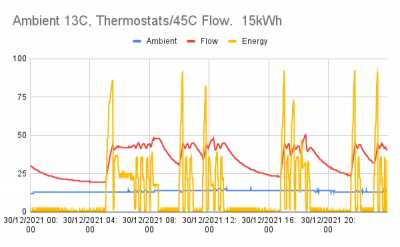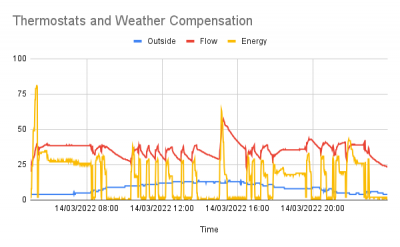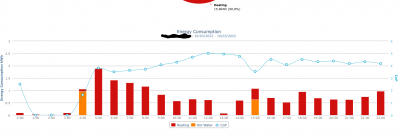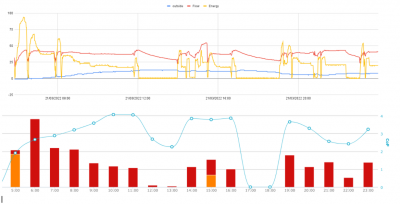Kev-M's ASHP Performance
The next round is to try and use weather compensation and thermostats together. Here’s what happened.
The theory is that setting a compensation curve that would normally make the house a few degrees too warm and limiting it by on/off thermostats will reduce cycling while keeping the house at a steady temperature. The aim is to get something like the below 45 deg set flow but with lower flow temps. Although even this didn't prevent all cycling.
But what actually happens is the weather compensation and thermostats just end up getting in each other's way. The thermostat causes ons and offs but in between there is a lot of cycling. This is because the ASHP will stop heating when either the thermostat temp (21 deg in my case) or the weather comp flow temp is reached and won’t start until the thermostat calls for heat and the weather comp flow temp is low. So the thermostat calls for heat and the ASHP starts heating. But the target flow temp is reached before the thermostat set temp, so the ASHP stops, even though the thermostat is still calling for heat. The flow (and the house) cool down a bit then the ASHP kicks in again. And repeats this until the thermostat set temp is eventually reached, at which time the ASHP stops, whether or not its flow temp is reached. The house then cools from 21.5 deg or so to 20.5 deg or so, the thermostat calls for heat and does it all again.
The below graph illustrates the above. You can see the 5am start up, the steady state running, the gaps when the thermostats switch the ASHP off and the 3pm DHW peak. There are only four periods of ASHP heating but these all include as much cycling as letting the ASHP run constantly.
The obvious way to stop the cycling is to increase the flow temp so that it requires a high enough output/flow, a bit like the fixed flow above. To get this to work the compensation curve is going to have to be very flat, not a million miles from the fixed flow.
But does it matter? Cycling for me is about twice an hour or so and in these conditions my COP is good. This was a warmish day using weather compensation only. I’d rather get the cold weather performance right...
But I like tinkering so I have now bumped up the warm end of the curve so that it’s 42 @ -2 and 33 at 20 and the thermostats are controlling the room temp. I'll report back.
This is what happened. There is almost no cycling. The outside temp was 0-12C. Is it better/cheaper? The house temperature varies more, which isn't as good. I don't know if it's cheaper but I suspect there won't be much in it. Although there are periods when the ASHP is off, the flow temp is several degrees higher than it needs to be. It's interesting to see the COP is low at very low ASHP consumption. This is because the ASHP itself is slightly less efficient at very low outputs and also because with the way COP is measured in my set up, the consumed energy is everything; the pumps, FTC controller the immersion (if it's used) and these are running all the time the ASHP is.
- 26 Forums
- 2,396 Topics
- 54.3 K Posts
- 279 Online
- 6,077 Members
Join Us!
Worth Watching
Latest Posts
-
RE: RDSAP10 effect on existing heat pump EPC rating?
@editor if possible please correct my reply above. In...
By Tim441 , 1 hour ago
-

RE: Setback savings - fact or fiction?
No need to create a new thread, @sheriff-fatman. You do...
By Majordennisbloodnok , 9 hours ago
-

RE: Power outages and storms: A surprisingly good DNO experience
Well done to Scottish Power for doing a good job. Well ...
By Majordennisbloodnok , 9 hours ago
-
RE: Advice for a novice on Mitsubishi Ecodan 6kW
Fair point. The highest frequency of defrosts I'd seen...
By Sheriff Fatman , 10 hours ago
-

RE: Heatpunk Floor plan issues
It's usually the complete opposite... seldom that Safar...
By Mars , 10 hours ago
-
RE: Recommended home battery inverters + regulatory matters - help requested
I remember reading in some inverters. They mandate a se...
By Batpred , 12 hours ago
-

RE: Fan is clipping ice build up from the front of unit.
@majordennisbloodnok I’ll not go there thanks! Toodles.
By Toodles , 13 hours ago
-

RE: Running from backup generaor in powercut?
@majordennisbloodnok Back in the 80’ or 90’ we had a te...
By Toodles , 13 hours ago
-
RE: Running my new Nibe ASHP efficiently
I'm new to the forum. Did you get a reply to this last ...
By Mike @ Camelot , 15 hours ago
-

RE: ASHP Energy Consumption: Aira 12kW heat pump
@grantmethestrength MCS requirements for DHW capacity h...
By Toodles , 15 hours ago
-
RE: New Mitsubishi Ecodan 11.2kW installation - L9 errors and maybe more
Great to hear! I just figured this out a day or tw...
By anotherdaveuk , 16 hours ago
-
RE: Help me keep the faith with my air source heat pump installation
@adamk I'm observing my own system at low temperatures ...
By dr_dongle , 21 hours ago
-

RE: Free Ecoheat Heat Pump Install
@deltona Yes older houses are problematic like that, bu...
By bontwoody , 2 days ago
-
RE: Radiator sizing sanity check
As I mentioned early on the cost of supplying and fitti...
By JamesPa , 2 days ago
-
RE: Electricity price predictions
Great point, one of the key ones in my chat with Octopu...
By Batpred , 2 days ago
-

RE: New Fogstar 15.5kWh upright solution
Let me point out that there are many Chinese suppliers ...
By Transparent , 3 days ago
-

RE: Weather compensation- why you should use it
@majordennisbloodnok — The Two Ronnies Mastermind sketc...
By cathodeRay , 3 days ago
-
Just realised that this image of the cylinder cupboard ...
By Sheriff Fatman , 3 days ago
-

RE: Rodents! A word of warning for heat pump owners
Two thoughts: 1: Let's ask @david-s if Primary Pro in...
By Transparent , 3 days ago
-
RE: Solis S6-EH1P8K-L-PLUS – Why I Chose It and What I’ve Learned So Far
In the diagram below, I describe my understanding of th...
By Batpred , 3 days ago







